
views
Prep the brick with an acid cleaner.

Clean the brick before you seal, paint, or overlay it. Sweep the brick to remove any surface dirt or dust, then dampen the bricks. Use a long-handled scrub brush to apply a 1:1 mixture of acid cleaner and water. Let the solution sit on the brick for 3-5 minutes, then scrub the bricks with your brush. A good cleaning might convince you that you don't need to cover your brick floors after all! Acid cleaners are harsh chemicals, so be sure to wear safety goggles and protective gloves while you're cleaning. Also, open any windows or doors to ventilate the area. These products are usually labeled as "acidic cleaners," "brick cleaners" or "masonry cleaners." You can also simply purchase phosphoric acid. If you prefer not to handle acid cleaners, scrub the floor with a wire brush and a mixture of ⁄2 cup (0.12 L) of trisodium phosphate (TSP) and 2 US gal (7.6 L) instead. You'll still need to wear goggles and gloves!
Seal your brick floors to give them a shine.
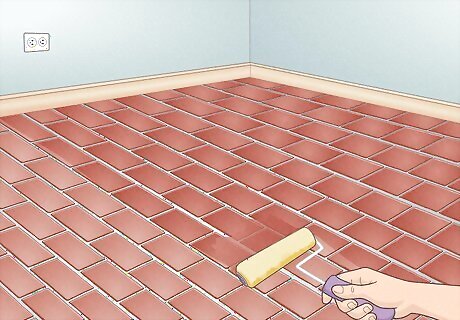
Sealing leaves the brick exposed but enhances its appearance. Brick is porous, so it needs to be sealed to keep out water. Sometimes, unsealed (or "unfinished") brick floors are used in an interior for a more rustic look. However, that leaves the brick more susceptible to mildew and staining as it absorbs moisture. Coating the brick in a sealant like polyurethane will help prevent this. Apply the sealant in thin layers with a paint roller or paintbrush. Be sure to carefully follow the label directions! Clean the floor thoroughly and let it dry completely before you seal it so you don't trap any dirt or moisture against the brick. You'll need to reapply the sealant every 3-5 years to keep your floors protected.
Whitewash the brick for a subtle change.
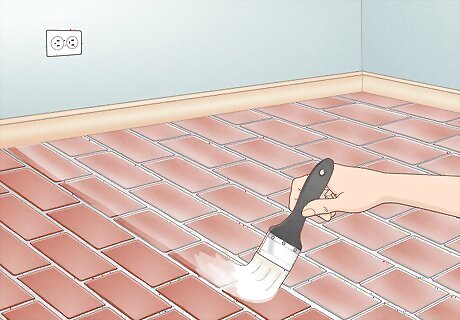
Whitewashing will allow the natural look of the brick to show through. Whitewashing doesn't completely cover the brick the way painting does—it creates a translucent finish that allows you to see the character of the brick while brightening up your space. Clean the floor thoroughly and let it dry, then mix equal parts white latex paint and water. Dip a brush into the mixture and wipe the excess on a grate, then apply it to the brick and grout in small sections and let it dry. For a more subtle effect, mix 1 part paint to 2 or 3 parts water. If you prefer, you can also dab the whitewash onto the brick with a rag. If the floor was previously painted, remove the old paint with a putty knife or wire brush.
Paint the brick to dramatically change the look.
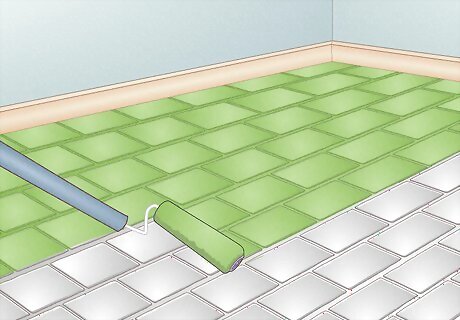
Prime the brick, then paint it any color you like. Use a paintbrush or paint roller to cover the floor with a latex primer. Allow that to dry for at least 24 hours, then go over the primer with an elastodynamic or acrylic latex paint. You may need two coats of paint to get the coverage you want. For a really fun look, try using large stencils to create patterns over the brick! Stencils that are 1 ft (0.30 m) or larger work best.
Use masonry stain to change the color without losing the look of brick.
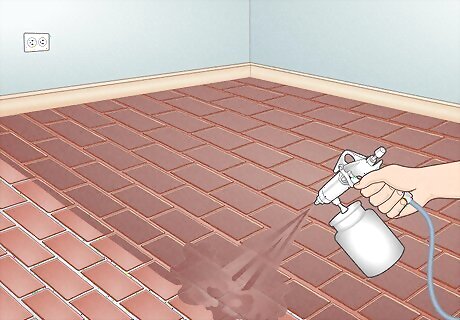
Staining the brick will still allow some of the natural variance to show through. When you paint brick, you get really consistent, opaque coverage. If you're hoping to preserve the unique character of your bricks but you just want a different color for your floor, stain might be a great option! Choose brick and masonry stain and mix it well. Then, apply the stain with a paintbrush or roller—or, to make the job easier and faster, use a paint sprayer. Unlike paint, stain will penetrate into the brick, so staining can be a longer-lasting option than painting.
Lay a plywood subfloor over the brick.
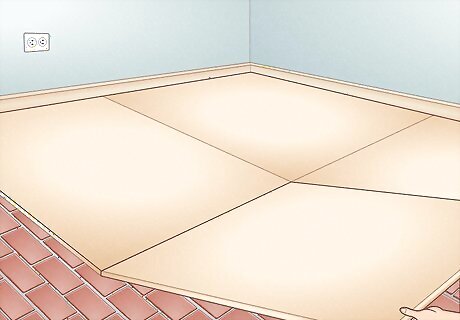
This is a must if you're working with an overlay. Between the grout and slight variations in the bricks themselves, brick floors are pretty uneven. That means it won't be an ideal subfloor if you want to lay down a different type of flooring. It's best to cover it with plywood so you can have a flat, even surface under your floor. Just remember to factor in the difference in height between your existing brick floor and the new floor with the plywood and overlay. For instance, it could make some doors harder to open.
Try a laminate flooring overlay for an inexpensive option.
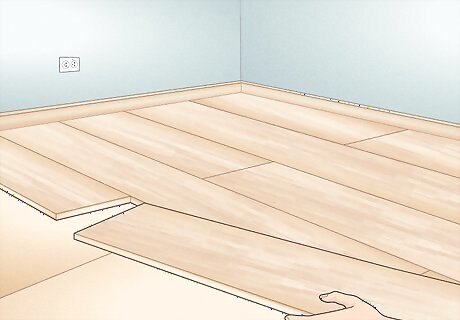
Laminate flooring looks like hardwood but costs way less. Install a laminate underlay on top of your subfloor. Then, install the laminate planks in your room, starting along the longest wall. Typically, they'll fit together in a tongue-and-groove pattern. Don't fit the laminate tightly against the wall—leave about ⁄4 in (1.9 cm) of extra space so the flooring can expand. The underlayment will protect the laminate from any moisture that may come up through the bricks and plywood, and it will also create a more comfortable walking surface. Laminate flooring is durable and inexpensive, but it's not water-resistant and may show wear over time.
Install a vinyl overlay if you need low-maintenance floors.

Get the look of hardwood or stone with luxury vinyl flooring (LVF). Vinyl flooring is sold in sheets, planks, or even stick-on tiles. The installation process depends on what type of vinyl flooring you buy. If you're laying planks, start by lining them up against the longest wall and work your way out through the room. Stick-on tiles are really easy to use—they just need to be pressed onto the subfloor. To install vinyl sheet flooring, create a large stencil of your floor with butcher paper and tape. Use a utility knife to cut the vinyl sheet, then spread the vinyl out in the room and attach it to the floor with double-sided tape.
Go with an engineered wood overlay for warmth and durability.
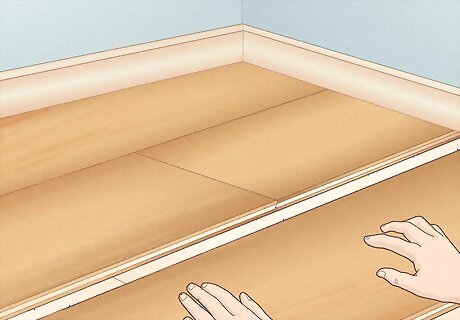
These are an excellent alternative to hardwood floors. Real wood floors have to be nailed into place, which won't work on top of your brick flooring. Engineered wood, on the other hand, fits together in a tongue-and-groove pattern, so each plank just snaps into place. It's actually made of layers of real wood, and you can put furniture on it the day after it's installed! To install the engineered floor, place a foam underlayment on top of your subfloor. Then, place your wood planks one at a time, starting parallel to the longest wall in the room.
Lay carpet over your subfloor for instant comfort.

Carpet makes any room cozier. Nail tack strips into the plywood near the walls, then put down a thick carpet pad and staple it into place. Once that's down, roll the carpet across the floor and tack it in place with a knee kicker. Laying carpet is pretty labor-intensive—consider having it professionally installed!
Go with an area rug for a temporary option.
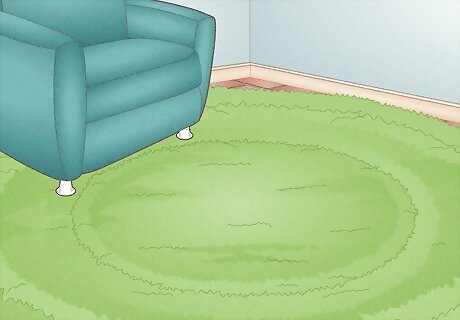
Rugs are great if you're renting or plan to sell. Brick floors can be really attractive to homebuyers, so you may not want to do anything that changes them permanently. That doesn't mean you have to deal with them if you're over the brick, though. Just put down a large area rug to cozy up the space. You can even use multiple rugs to designate different areas in the room, like a large circular rug under a table and a rectangular rug in front of your sofa.

















Comments
0 comment